云计算于大数据入门实验三——熟悉常用的 HBase 操作
实验目的
理解HBase在Hadoop体系结构中的角色
熟练使用HBase操作常用的shell命令
熟悉HBase操作常用的Java API
实验要求
-
保存程序,并自行存档
-
最终的程序都必须经过测试,验证是正确的
-
按照实验报告格式,认真记录实验过程及结果,回答实验报告中的问题。实验报告模板在学习通的资料里面下载。学生提交的实验报告需转换成PDF文件提交
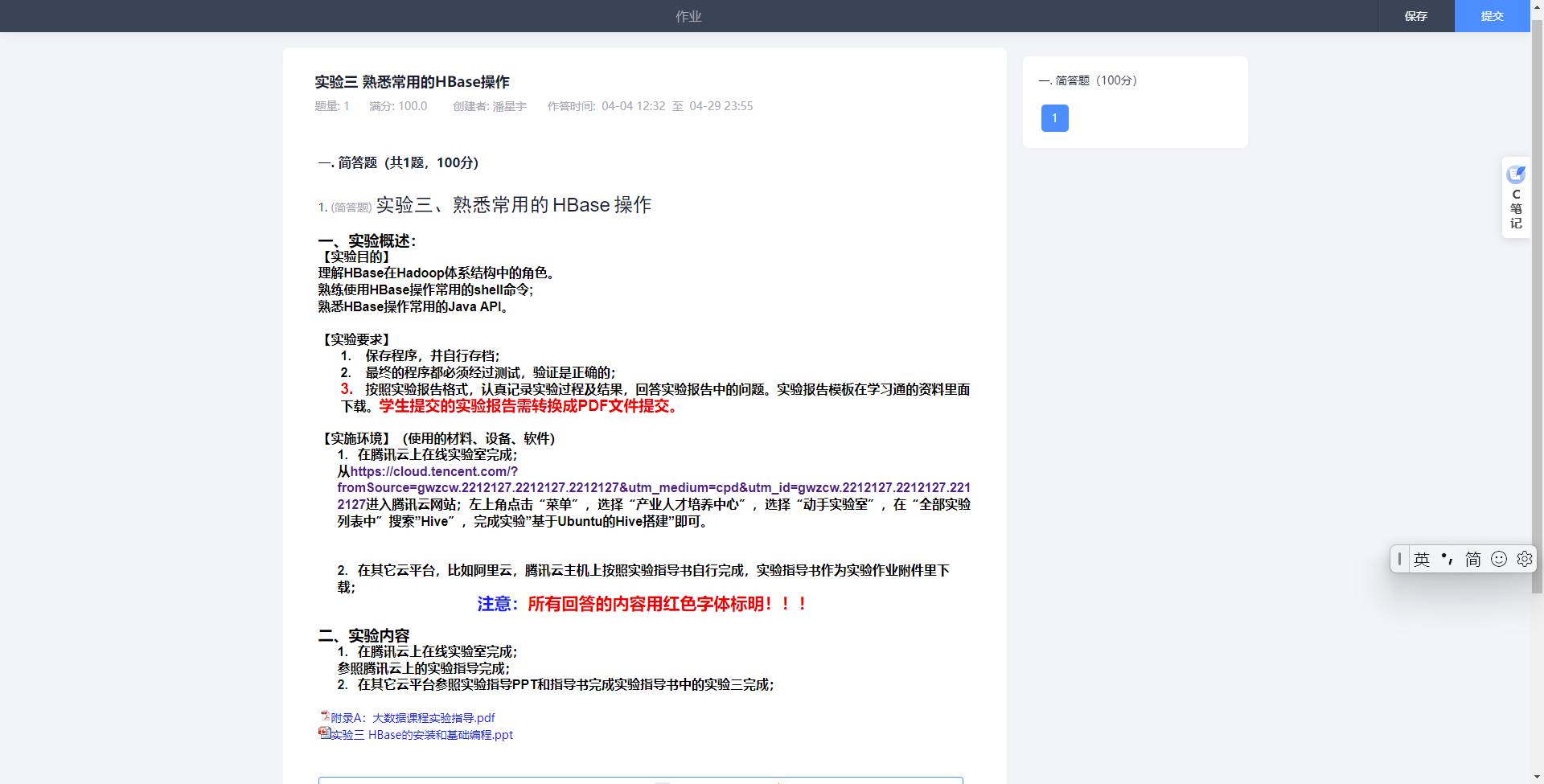
实验步骤
Hbase 常用命令
- 在 Hbase 中建表
create 'student','Sname','Ssex','Sage','Sdept','course'
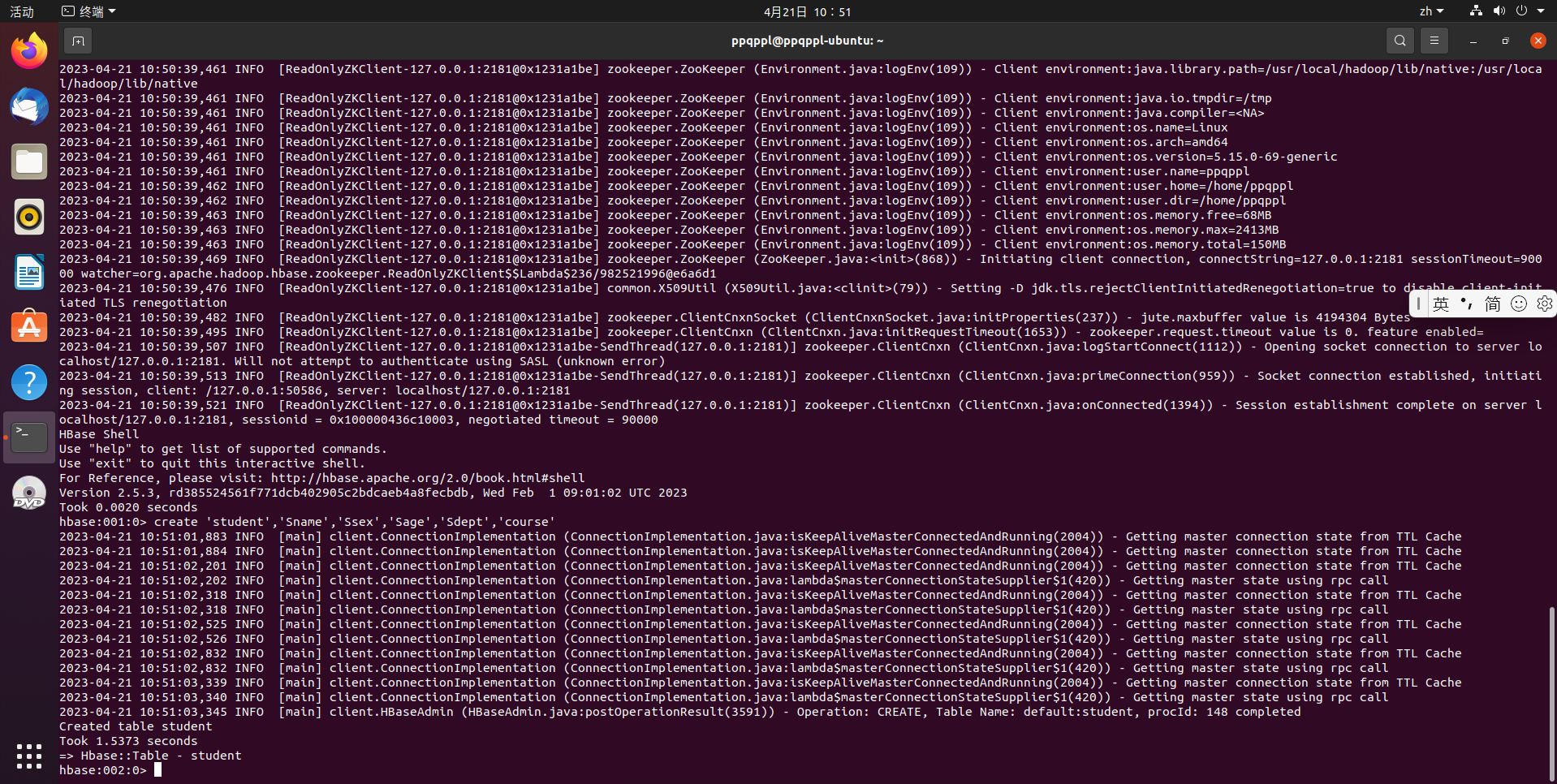
- 查看表结构
describe 'student'
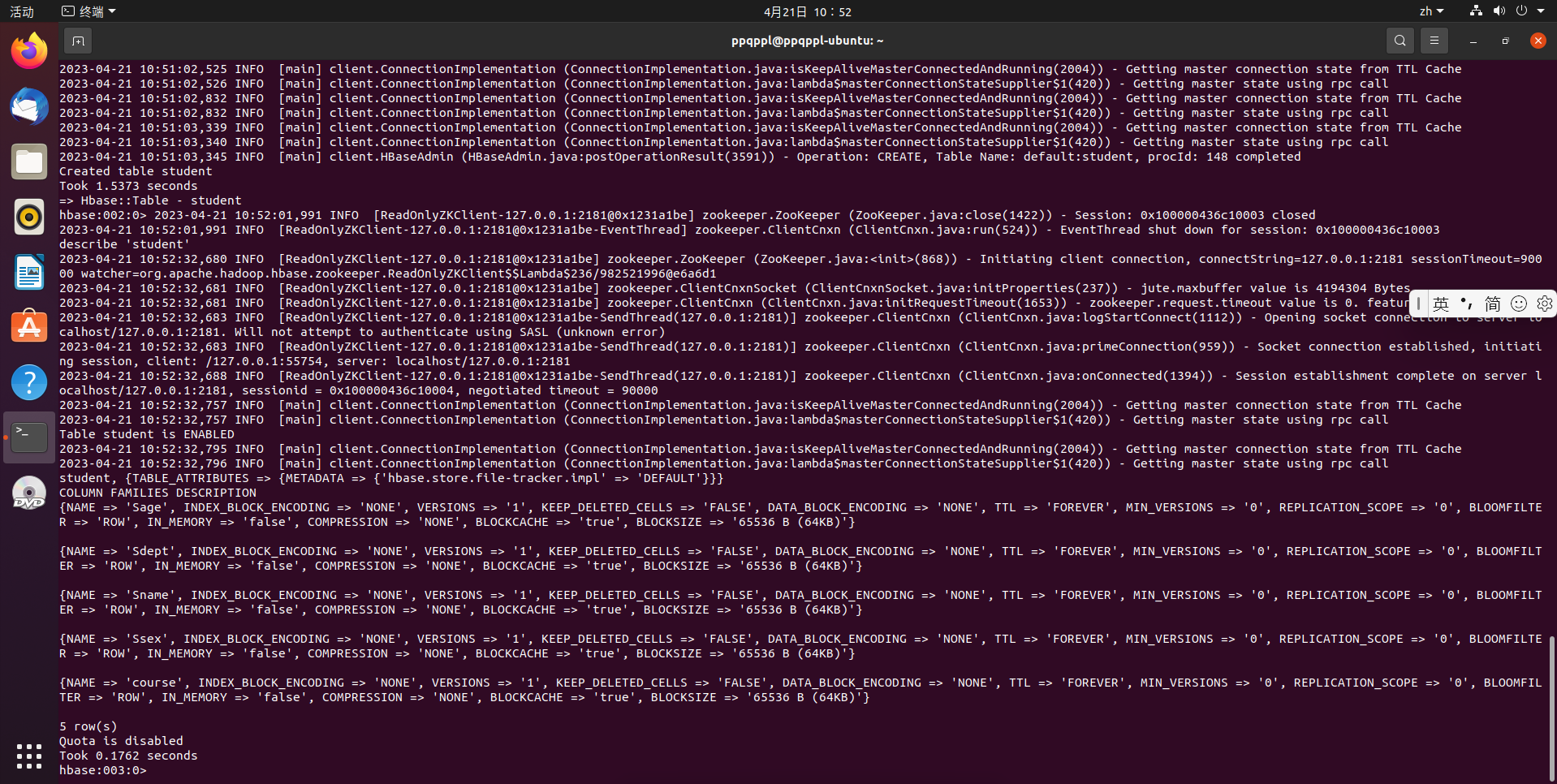
- 添加数据
put 'student', '95001','Sname','LiYing' put 'student','95001','course:math','80'
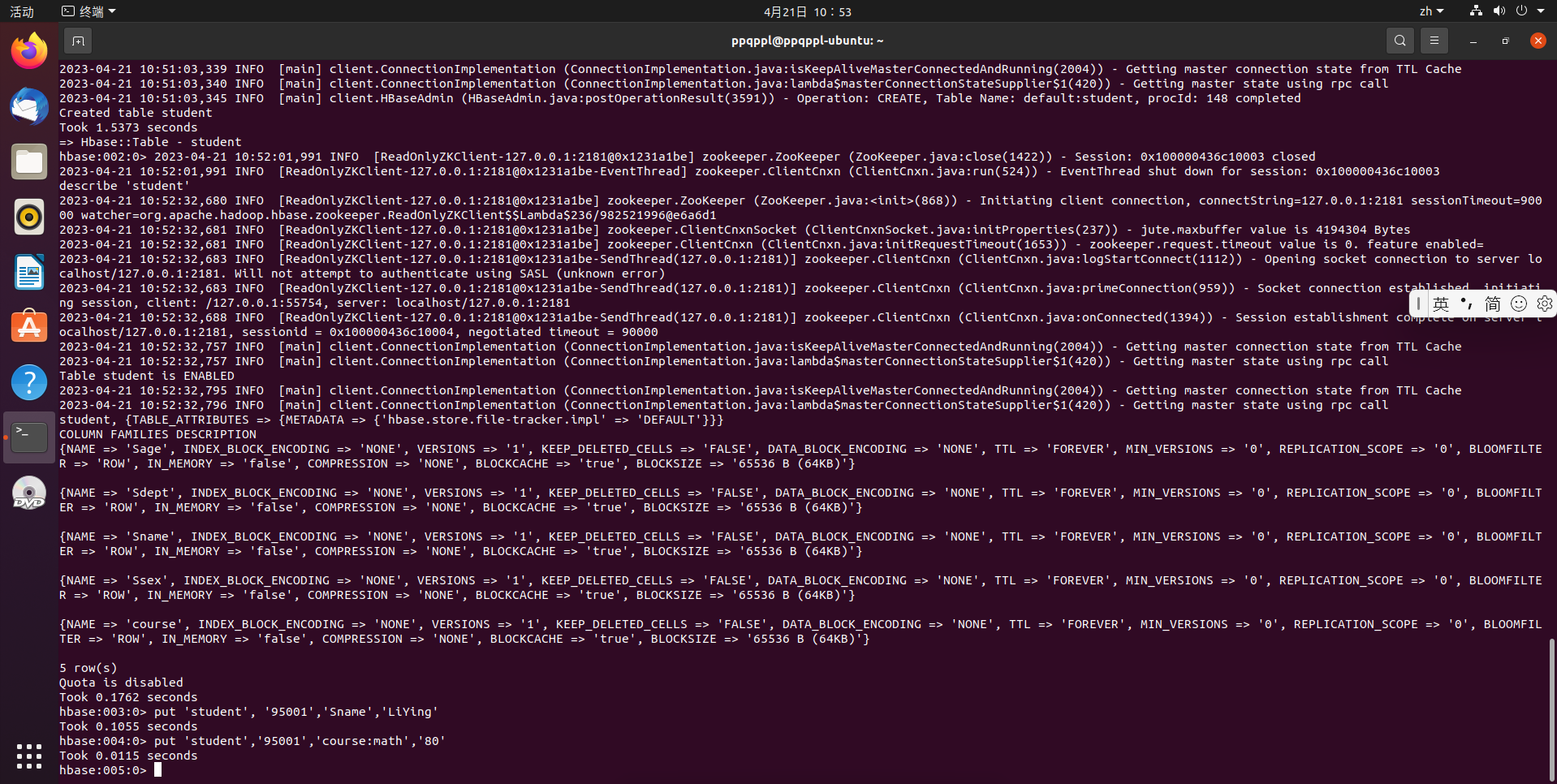
- 查看数据
get 'student','95001'
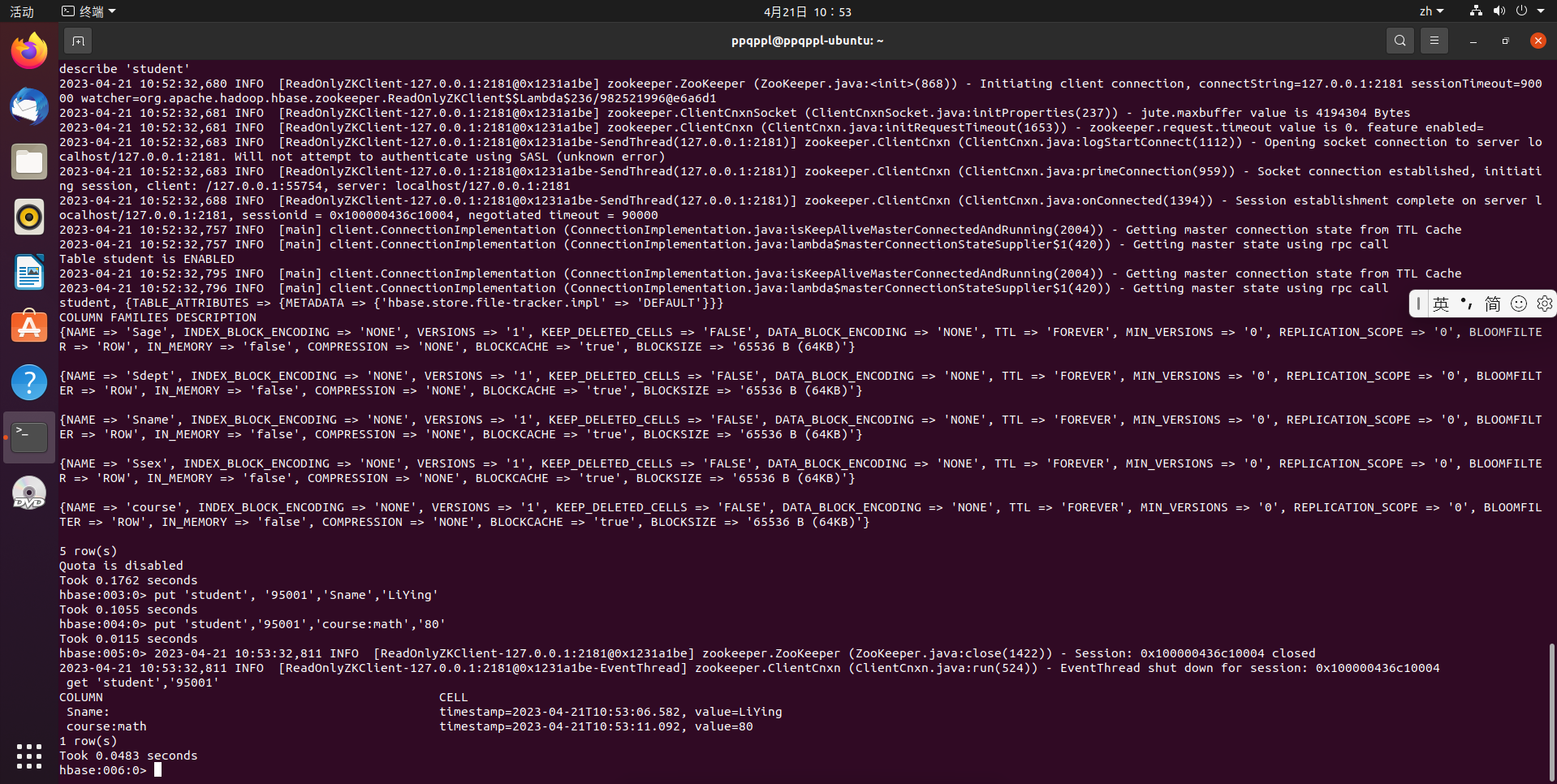
- 删除数据
delete 'student','95001','Sname:firstName' deleteall 'student','95001'
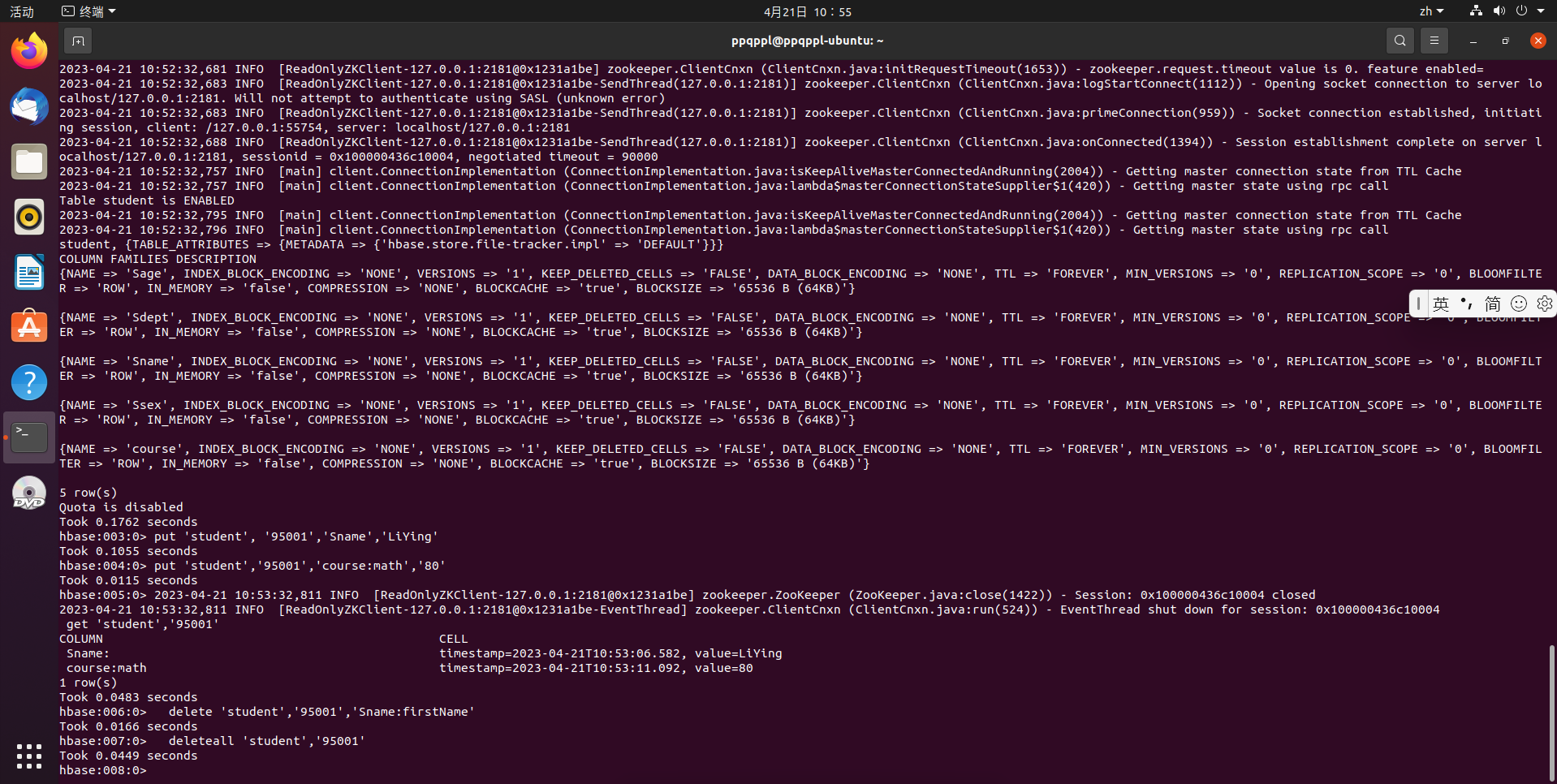
- 删除表
disable 'student' #让表不可用 drop 'student' #删除表
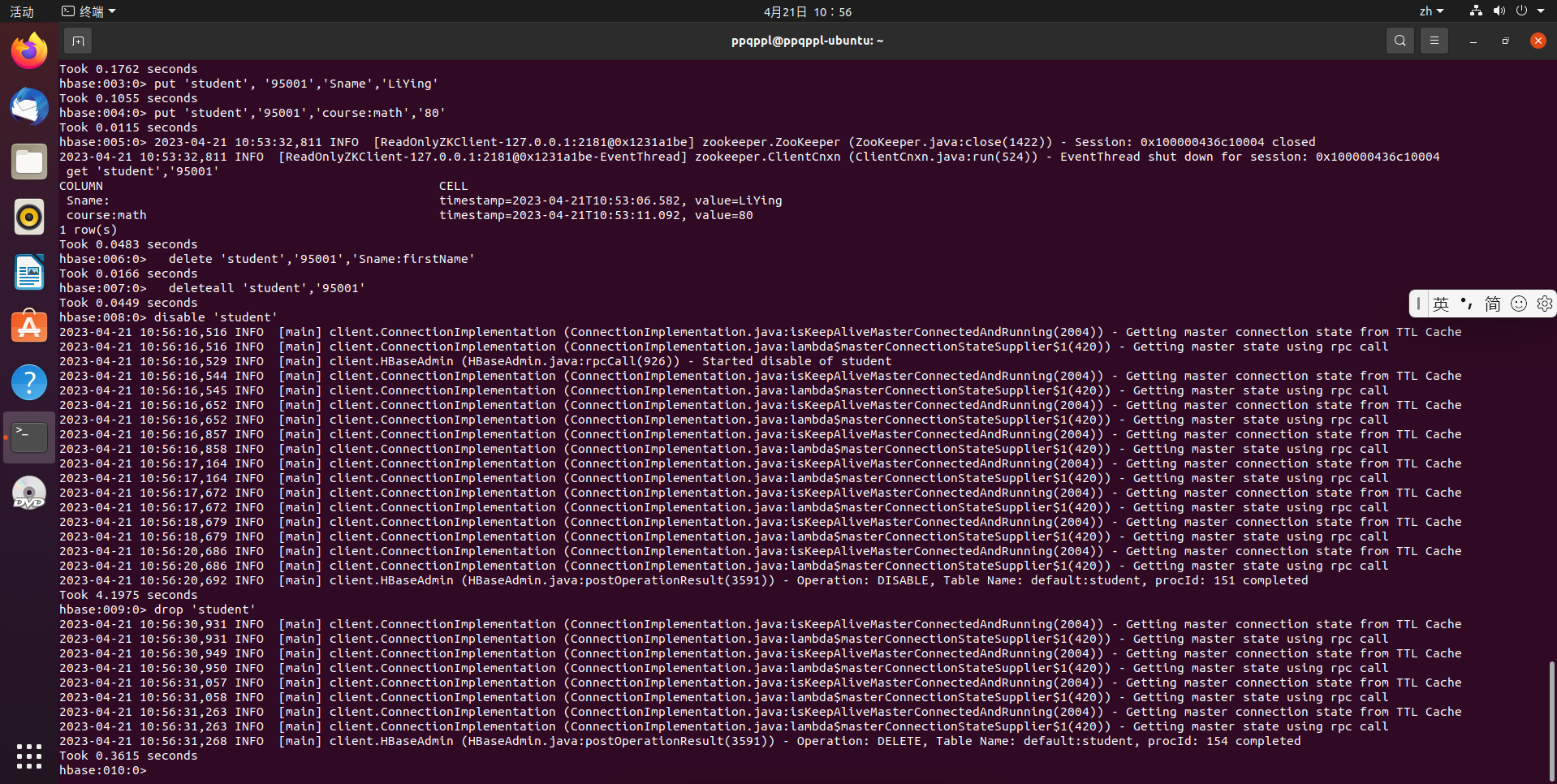
- 查询历史数据
create 'teacher',{NAME=>'username',VERSIONS=>5}
put 'teacher','91001','username','Mary'
put 'teacher','91001','username','Mary1'
put 'teacher','91001','username','Mary2'
put 'teacher','91001','username','Mary3'
put 'teacher','91001','username','Mary4'
put 'teacher','91001','username','Mary5'
get 'teacher','91001',{COLUMN=>'username',VERSIONS=>3}
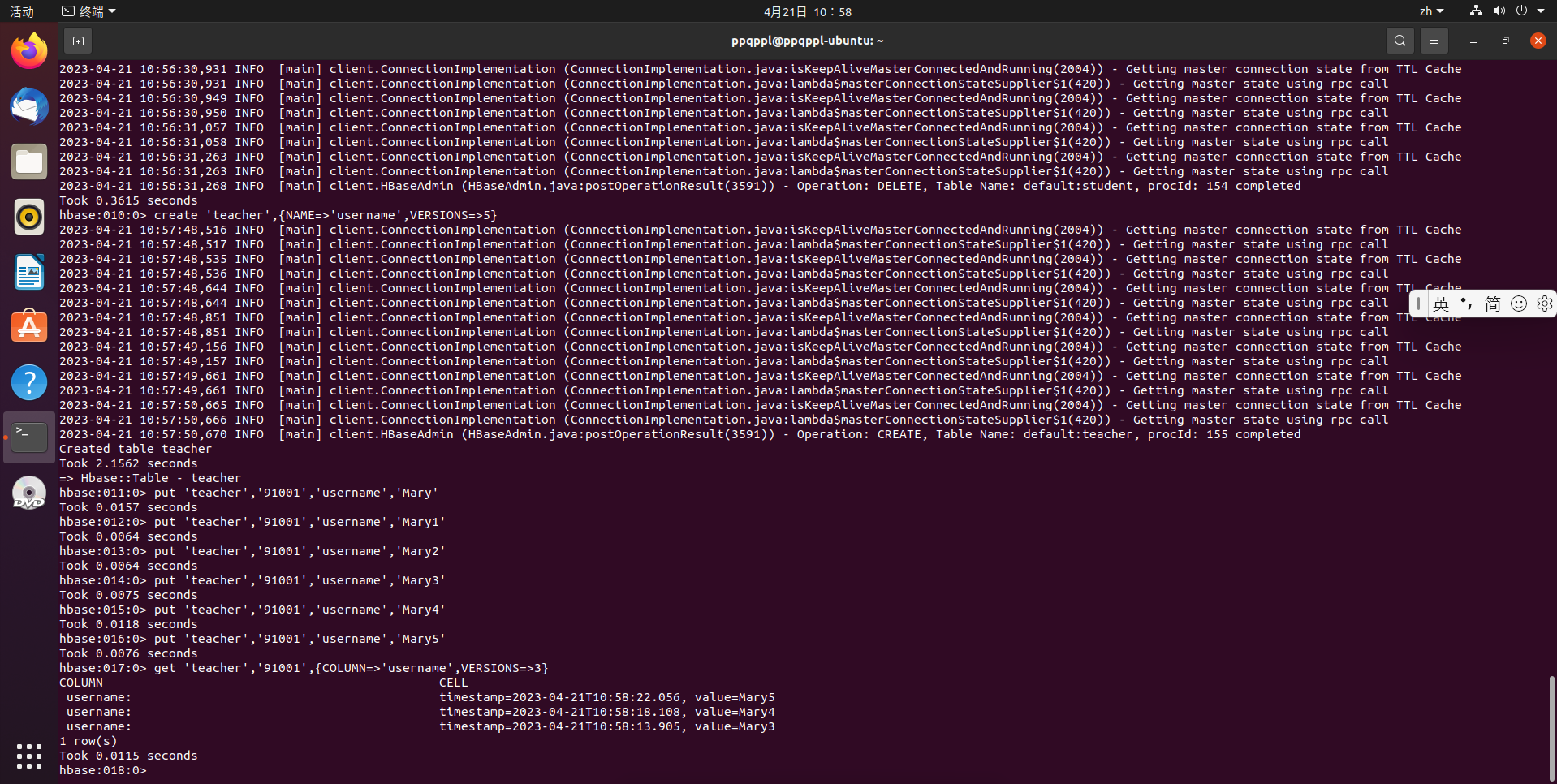
- 退出 HBase
exit
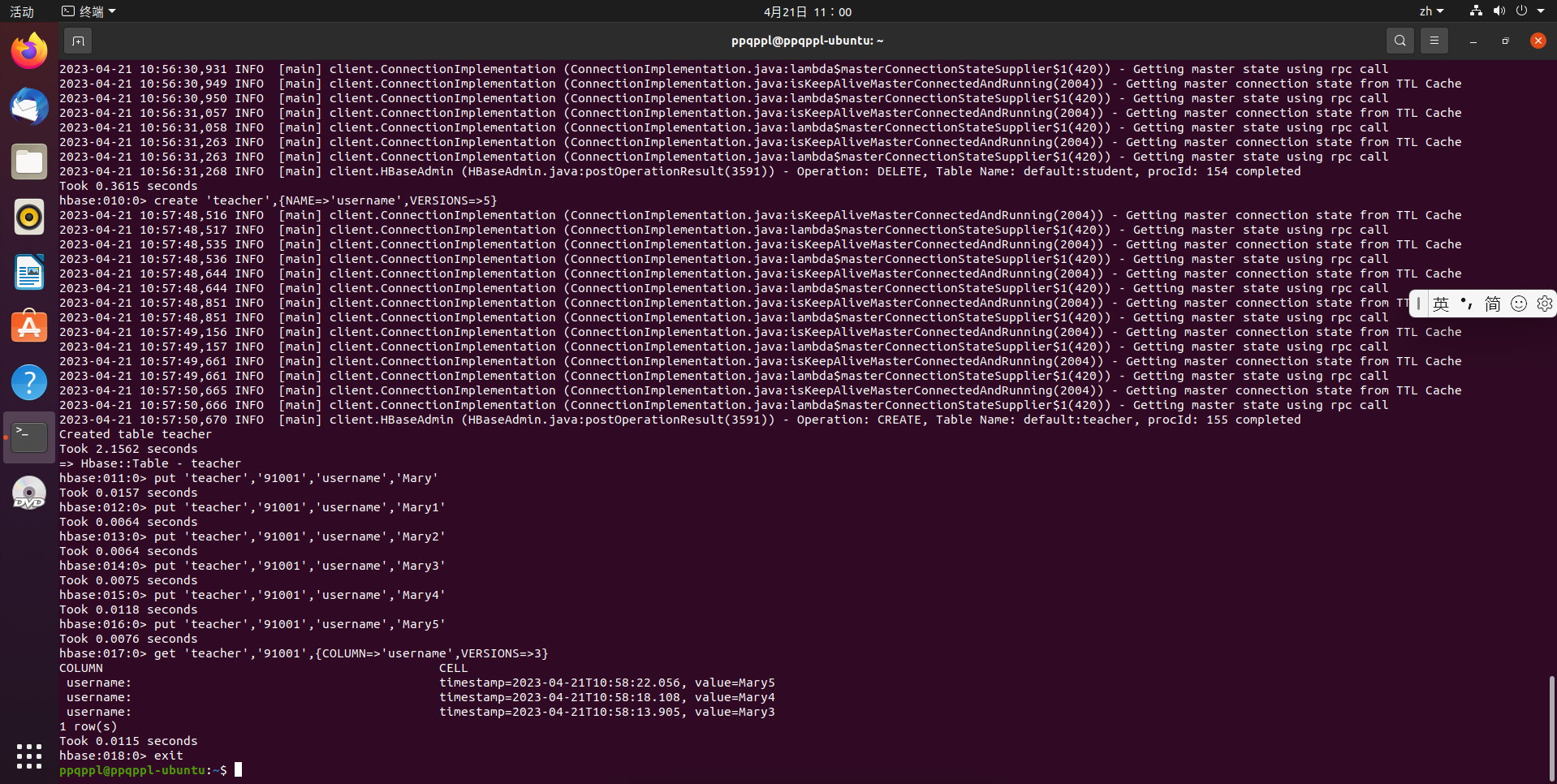
编程实践
例子:创建表,插入数据,查看表中数据
import org.apache.hadoop.conf.Configuration;
import org.apache.hadoop.hbase.*;
import org.apache.hadoop.hbase.client.*;
import org.apache.hadoop.hbase.util.Bytes;
import java.io.IOException;
public class ExampleForHBase {
public static Configuration configuration;
public static Connection connection;
public static Admin admin;
public static void main(String[] args)throws IOException{
init(); //主要操作就是为了连接到数据库hbase
createTable("student",new String[]{"score"}); //创建表,shell命令:create '表名','列族名1','列族名2','列族名3' ...
insertData("student","zhangsan","score","English","69"); //shell命令: put 'student','张三','score:English','69'
insertData("student","zhangsan","score","Math","86");
insertData("student","zhangsan","score","Computer","77");
getData("student", "zhangsan", "score","English");
close();
}
public static void init(){
configuration = HBaseConfiguration.create();
configuration.set("hbase.rootdir","hdfs://localhost:9000/hbase");
try{
connection = ConnectionFactory.createConnection(configuration);
admin = connection.getAdmin();
}catch (IOException e){
e.printStackTrace();
}
}
public static void close(){
try{
if(admin != null){
admin.close();
}
if(null != connection){
connection.close();
}
}catch (IOException e){
e.printStackTrace();
}
}
public static void createTable(String myTableName,String[] colFamily) throws IOException {
TableName tableName = TableName.valueOf(myTableName);
if(admin.tableExists(tableName)){
System.out.println("talbe is exists!");
}else {
TableDescriptorBuilder tableDescriptor = TableDescriptorBuilder.newBuilder(tableName);
for(String str:colFamily){
ColumnFamilyDescriptor family =
ColumnFamilyDescriptorBuilder.newBuilder(Bytes.toBytes(str)).build();
tableDescriptor.setColumnFamily(family);
}
admin.createTable(tableDescriptor.build());
}
}
public static void insertData(String tableName,String rowKey,String colFamily,String col,String val) throws IOException {
Table table = connection.getTable(TableName.valueOf(tableName));
Put put = new Put(rowKey.getBytes());
put.addColumn(colFamily.getBytes(),col.getBytes(), val.getBytes());
table.put(put);
table.close();
}
public static void getData(String tableName,String rowKey,String colFamily, String col)throws IOException{
Table table = connection.getTable(TableName.valueOf(tableName));
Get get = new Get(rowKey.getBytes());
get.addColumn(colFamily.getBytes(),col.getBytes());
Result result = table.get(get);
System.out.println(new String(result.getValue(colFamily.getBytes(),col==null?null:col.getBytes())));
table.close();
}
}
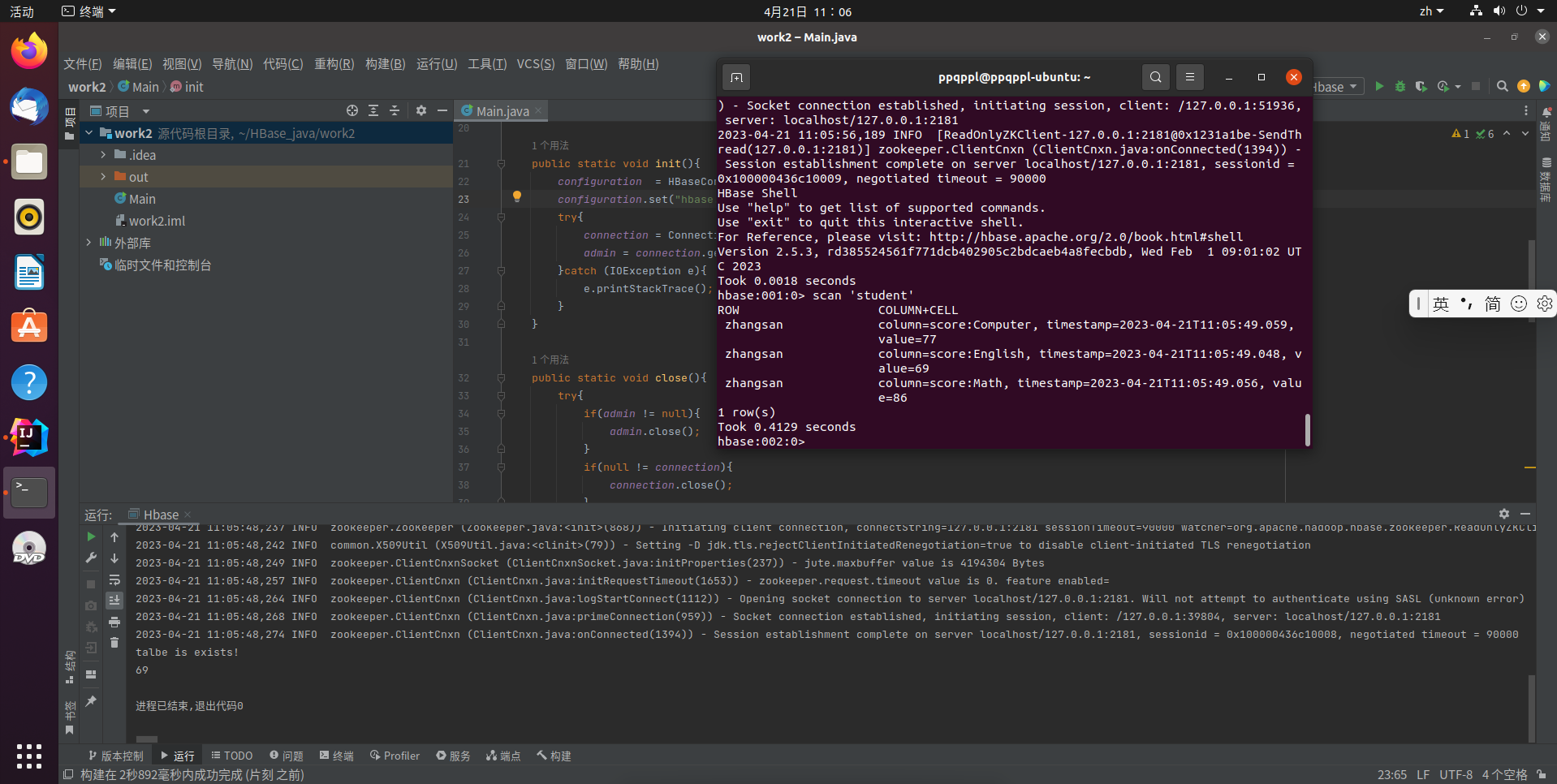
实验三 熟悉常用的HBase 操作
编程实现以下指定功能,并用 Hadoop 提供的 HBase Shell 命令完成相同任务:
-
列出 HBase 所有的表的相关信息,例如表名;
-
在终端打印出指定的表的所有记录数据;
-
向已经创建好的表添加和删除指定的列族或列;
-
清空指定的表的所有记录数据;
-
统计表的行数。
列出 HBase 所有的表的相关信息,例如表名:
/** * 同样是正常的建立 数据库连接,执行操作,然后最后关闭连接 * 重点是:HTableDescriptor hTableDescriptors[] = admin.listTables(); 获取到 表格列表,然后遍历 */ import java.io.IOException; import org.apache.hadoop.conf.Configuration; import org.apache.hadoop.hbase.*; import org.apache.hadoop.hbase.client.*; import java.io.IOException; public class Test_1 { public static Configuration configuration; public static Connection connection; public static Admin admin; /** * 建立连接 */ public static void init() { configuration = HBaseConfiguration.create(); configuration.set("hbase.rootdir", "hdfs://localhost:9000/hbase"); try { connection = ConnectionFactory.createConnection(configuration); admin = connection.getAdmin(); } catch (IOException e) { e.printStackTrace(); } } /** * 关闭连接 */ public static void close() { try { if (admin != null) { admin.close(); } if (null != connection) { connection.close(); } } catch (IOException e) { e.printStackTrace(); } } /** * * 查看已有表,通过方法listTables() * * @throws IOException * */ public static void listTables() throws IOException { init(); HTableDescriptor hTableDescriptors[] = admin.listTables(); for (HTableDescriptor hTableDescriptor : hTableDescriptors) { System.out.println(hTableDescriptor.getNameAsString()); } close(); } public static void main(String[] args) { Test_1 t = new Test_1(); try { System.out.println("以下为Hbase 数据库中所存的表信息"); t.listTables(); } catch (IOException e) { e.printStackTrace(); } } }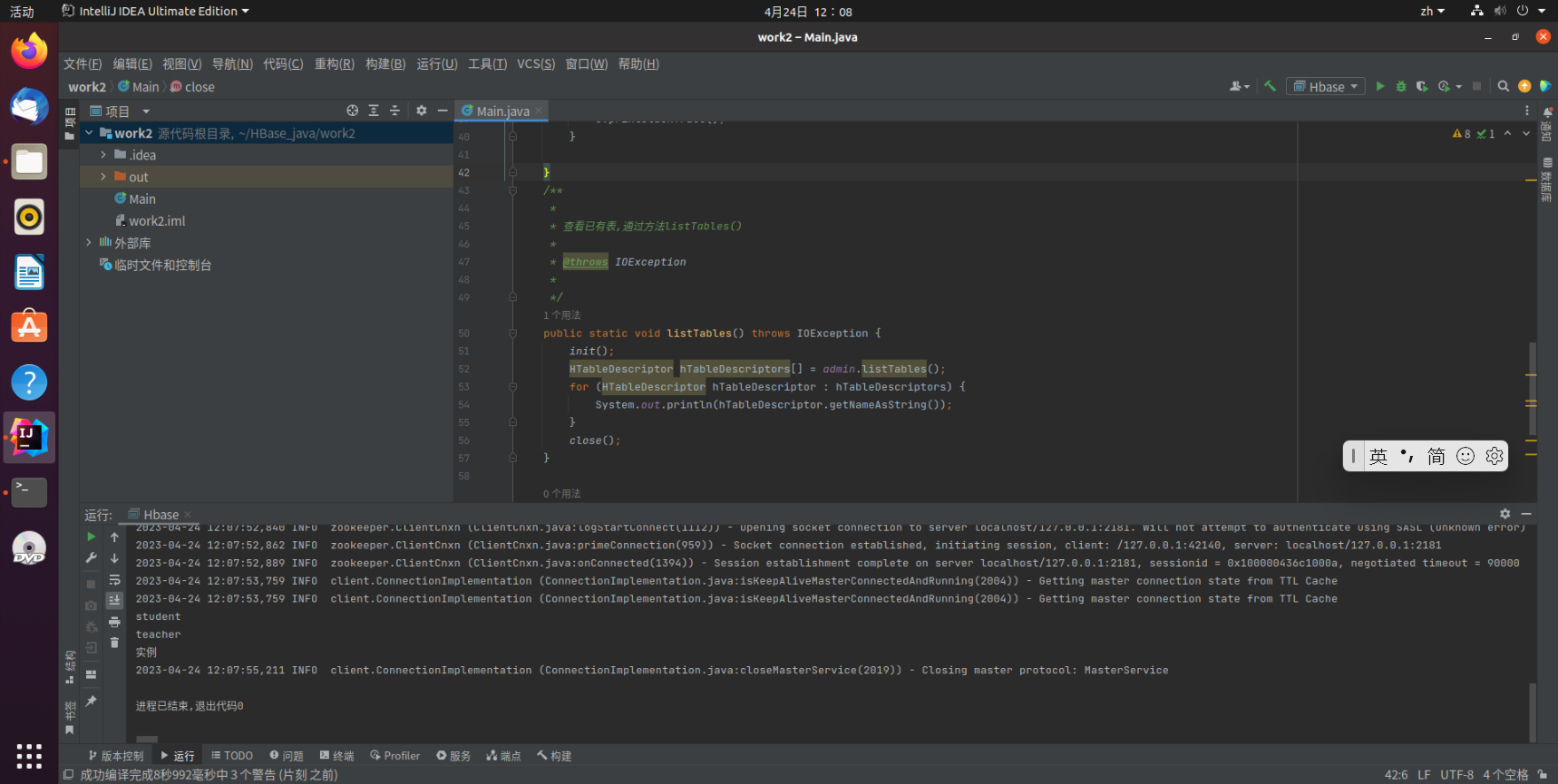
在终端打印出指定的表的所有记录数据;
/** * 同样是正常的建立 数据库连接,执行操作,然后最后关闭连接 * 重点是: * Table table = connection.getTable(TableName.valueOf(tableName));获取到表格对象 * Scan scan = new Scan(); ResultScanner scanner = table.getScanner(scan); 然后通过Scanner对象,获取到ResultScanner扫描结果对象,遍历输出 */ import java.io.IOException; import org.apache.hadoop.conf.Configuration; import org.apache.hadoop.hbase.*; import org.apache.hadoop.hbase.client.*; import java.io.IOException; import java.util.Scanner; public class Test_2 { public static Configuration configuration; public static Connection connection; public static Admin admin; // 建立连接 public static void init() { configuration = HBaseConfiguration.create(); configuration.set("hbase.rootdir", "hdfs://localhost:9000/hbase"); try { connection = ConnectionFactory.createConnection(configuration); admin = connection.getAdmin(); } catch (IOException e) { e.printStackTrace(); } } // 关闭连接 public static void close() { try { if (admin != null) { admin.close(); } if (null != connection) { connection.close(); } } catch (IOException e) { e.printStackTrace(); } } /** * * 根据表名查找表信息 * */ public static void getData(String tableName) throws IOException { init(); Table table = connection.getTable(TableName.valueOf(tableName)); Scan scan = new Scan(); ResultScanner scanner = table.getScanner(scan); for (Result result : scanner) { showCell((result)); } close(); } /** * * 格式化输出 * * @param result * */ public static void showCell(Result result) { Cell[] cells = result.rawCells(); for (Cell cell : cells) { System.out.println("RowName(行键):" + new String(CellUtil.cloneRow(cell)) + " "); System.out.println("Timetamp(时间戳):" + cell.getTimestamp() + " "); System.out.println("column Family(列簇):" + new String(CellUtil.cloneFamily(cell)) + " "); System.out.println("column Name(列名):" + new String(CellUtil.cloneQualifier(cell)) + " "); System.out.println("value:(值)" + new String(CellUtil.cloneValue(cell)) + " "); System.out.println(); } } public static void main(String[] args) throws IOException { // TODO Auto-generated method stub Test_2 t = new Test_2(); System.out.println("请输入要查看的表名"); Scanner scan = new Scanner(System.in); String tableName = scan.nextLine(); System.out.println("信息如下:"); t.getData(tableName); } }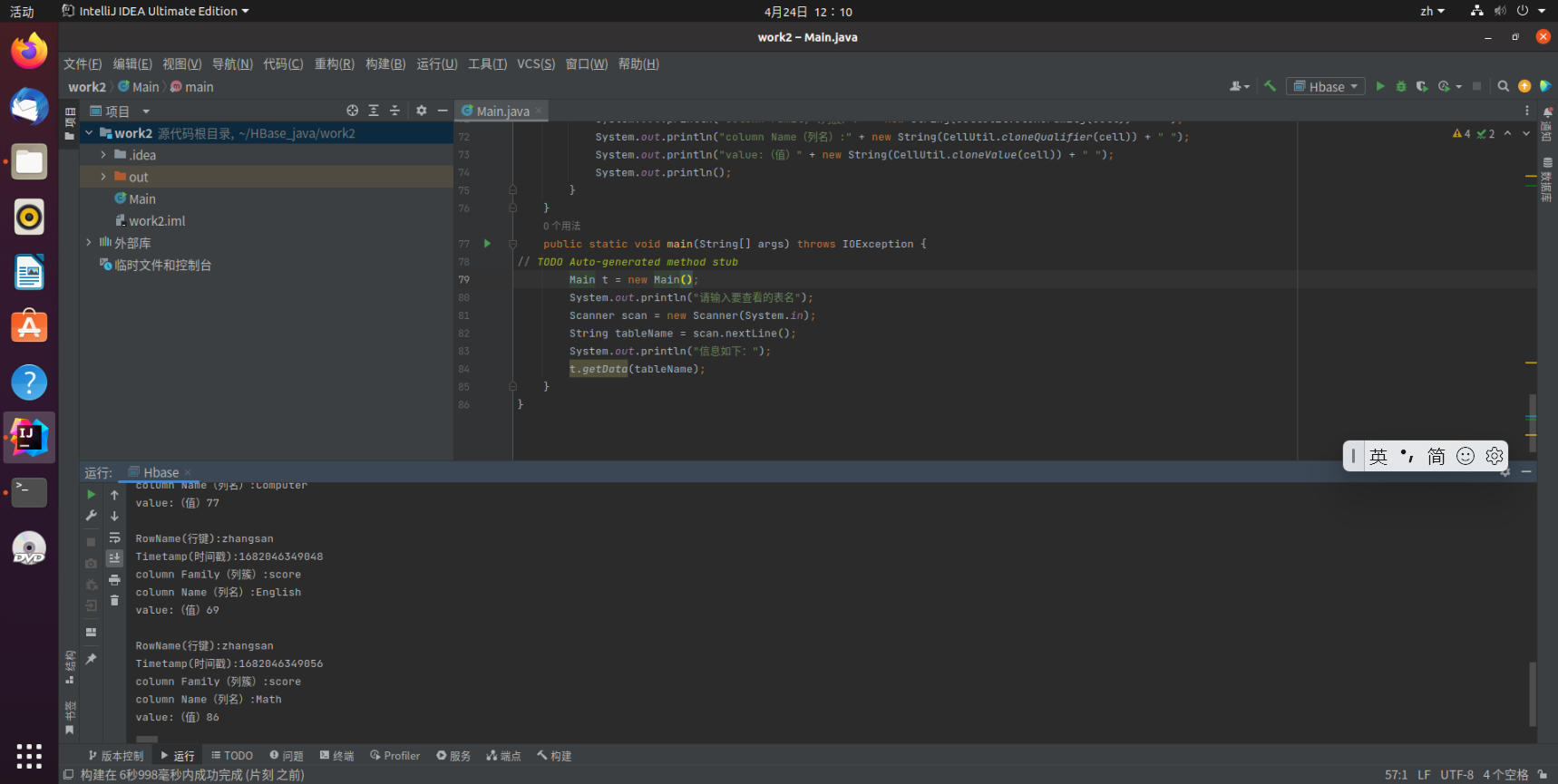
向已经创建好的表添加和删除指定的列族或列:
put 'student','95003','Sname','wangjinxuan' (添加列) put 'student','95003','Sname:nickName','wang' (添加列族) put 'student','95003','Sname:firstName','jinxuan' (添加列族) put的反向操作的delete: delete 'student' ,’95003’,’Sname’ delete 'student' ,’95003’,’Sname:nickName’ deleteall 'student' ,’95003’ (删除整个行记录)
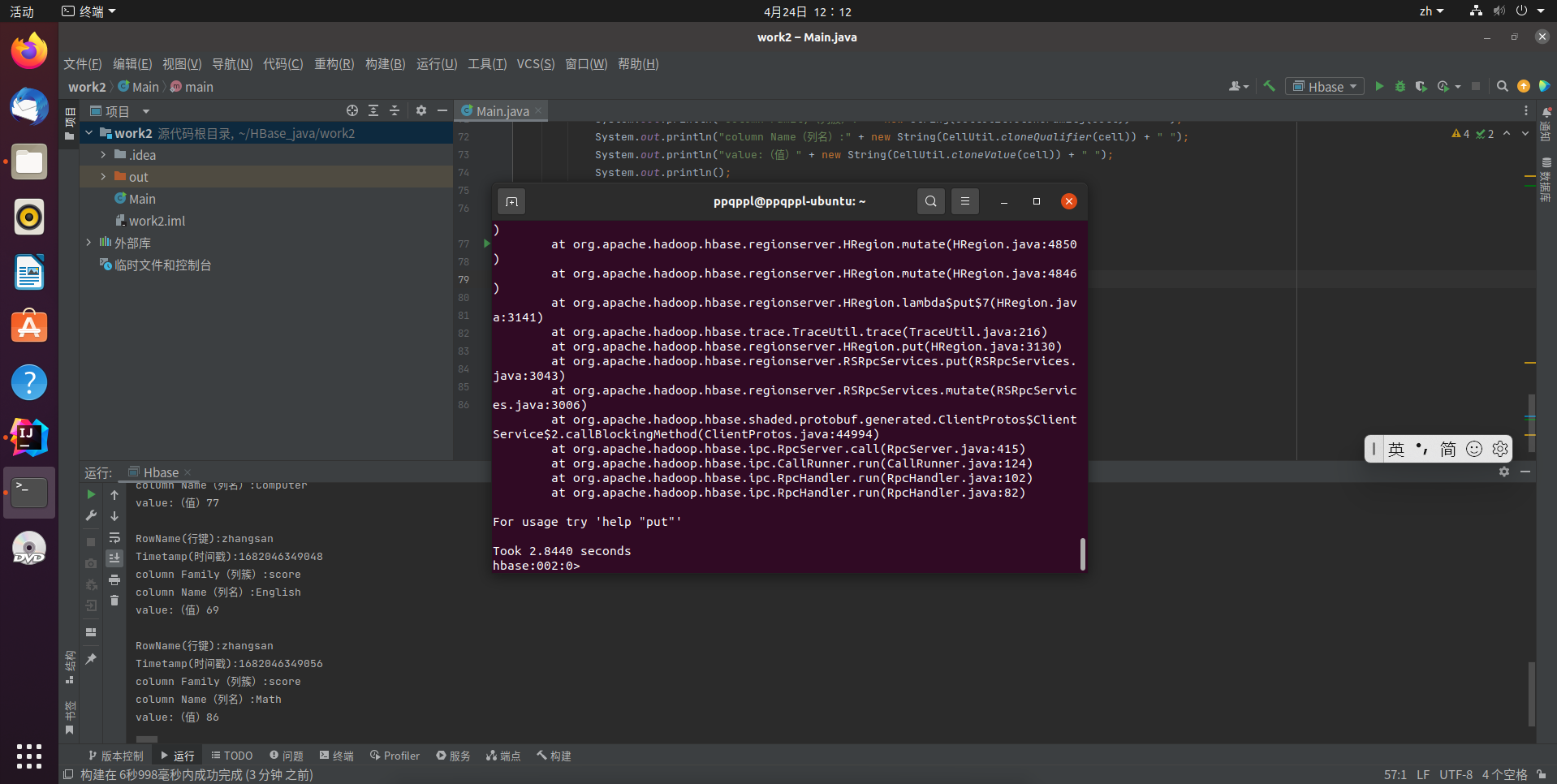
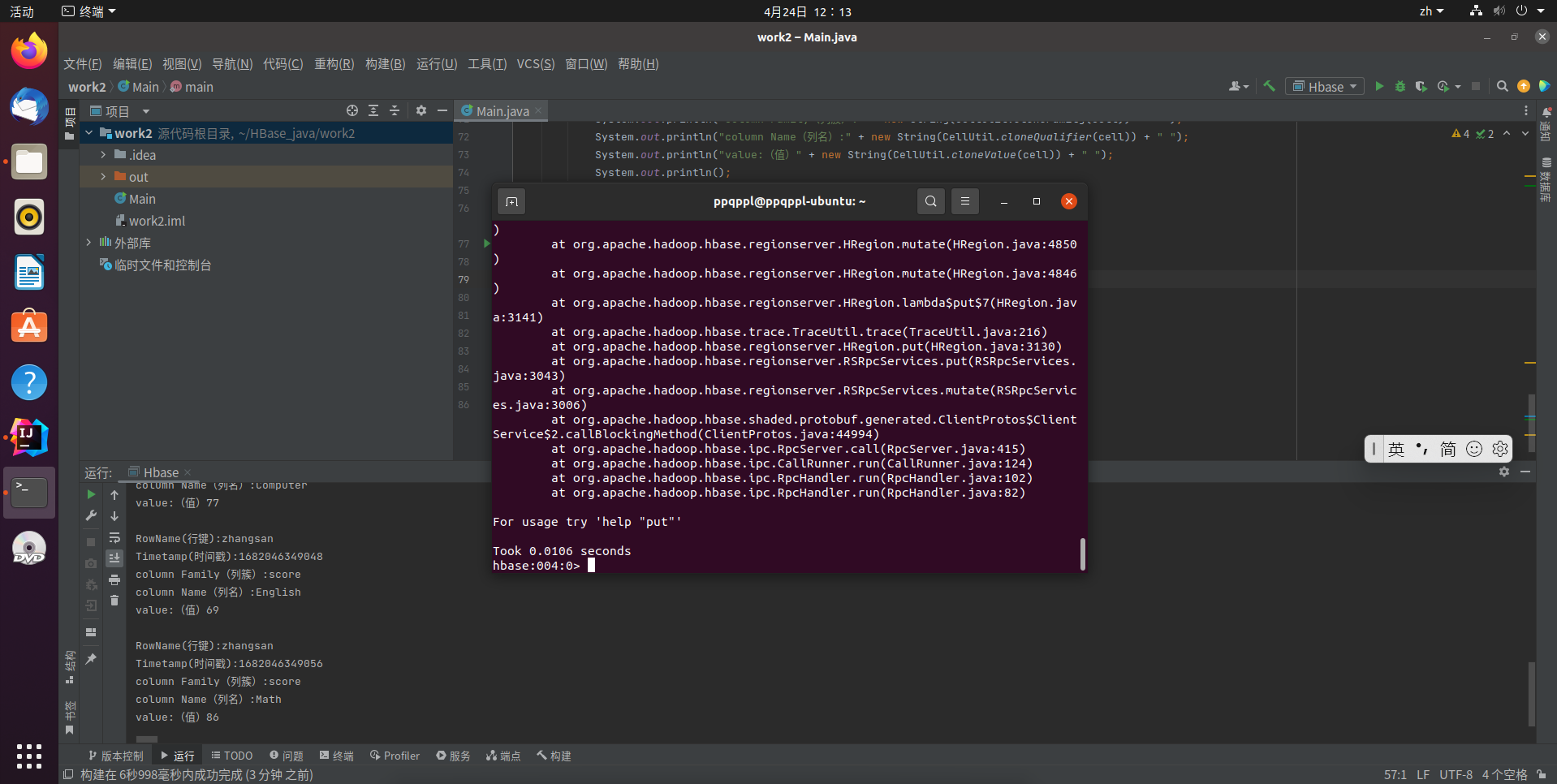
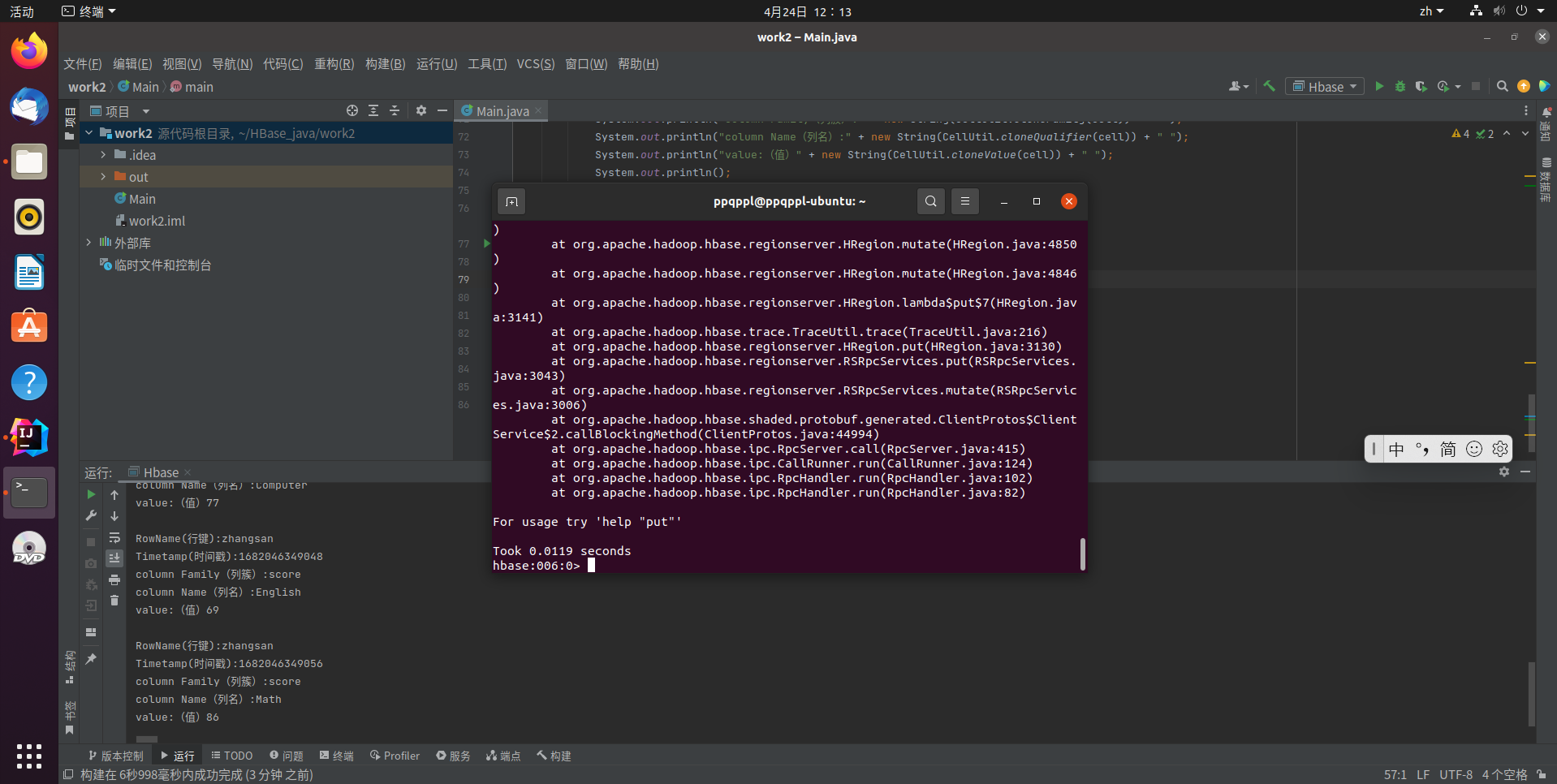
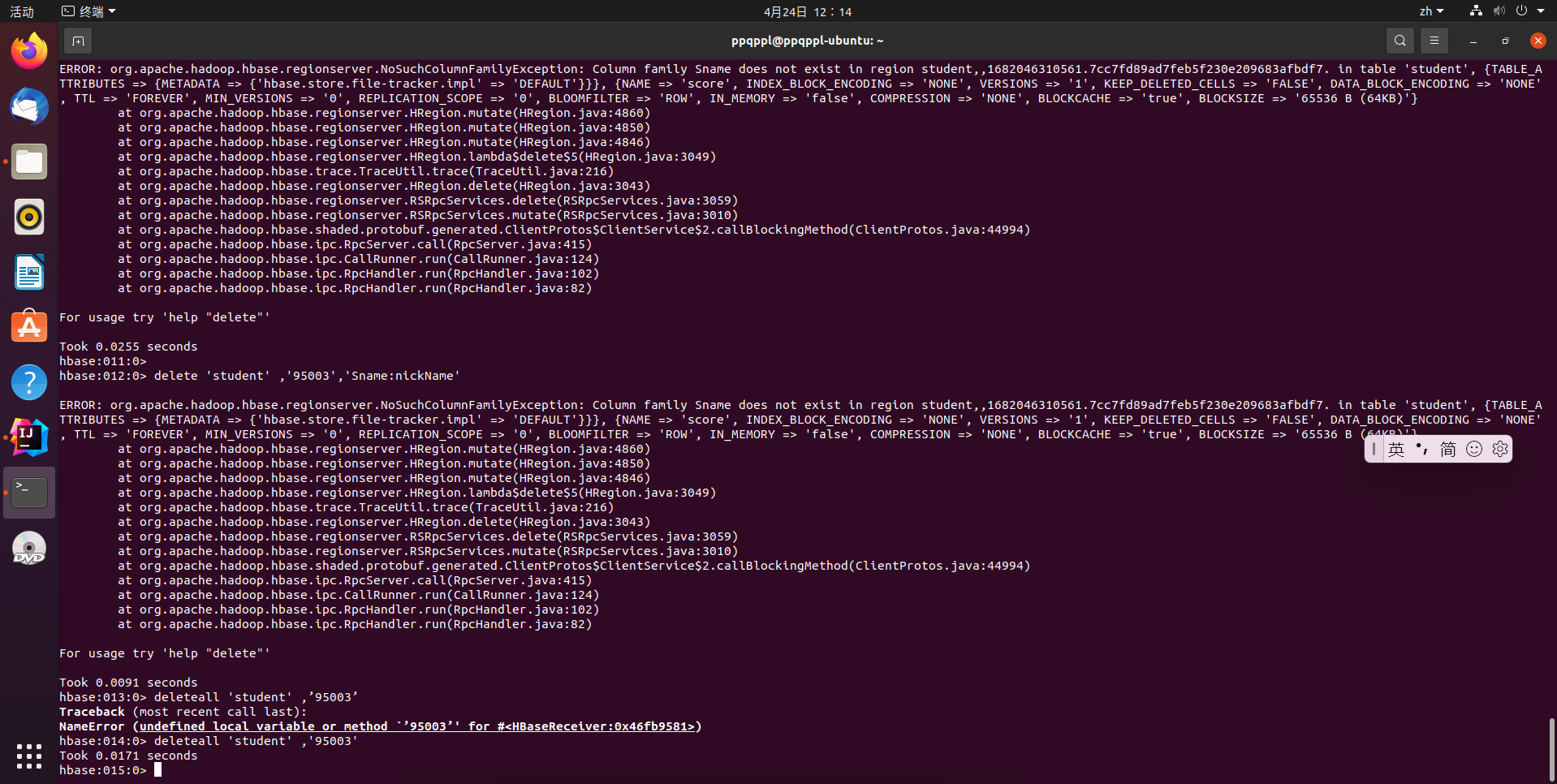
/** * hbase只关注rowkey,column Family(列族),并没有说在创建表的时候指定cq(列限定修饰符)有多少,这也是hbase列式存储的特点, * 所以在hbase API中是没有提供delete 一个列下的所有数据的 * * 同样是正常的建立 数据库连接,执行操作,然后最后关闭连接 * 1,Table table = connection.getTable(TableName.valueOf(tableName)); 先获取到表 * 2,插入:(① 创建Put对象,② 然后通过方法 addColumn将列、列限定符、值 放到put对象,③ 最后将put对象put到表格) * Put put = new Put(rowKey.getBytes()); * put.addColumn(colFamily.getBytes(), col.getBytes(), val.getBytes()); * table.put(put); * 3,删除: * Table table = connection.getTable(TableName.valueOf(tableName)); 同样首先获取到表 * Delete delete = new Delete(rowKey.getBytes()); //通过传入行键,new一个删除对象 * //删除对象添加要被删除的列或列族 * ① 删除指定列族的所有数据(此情况是列族下无列限定符时的情况):delete.addFamily(colFamily.getBytes()); * ② 删除指定列的数据(此列主要说的是列限定修饰符):delete.addColumn(colFamily.getBytes(), col.getBytes()); * table.delete(delete); //最后就是表格delete掉 delete对象 */ import java.io.IOException; import java.util.Scanner; import org.apache.hadoop.conf.Configuration; import org.apache.hadoop.hbase.Cell; import org.apache.hadoop.hbase.CellUtil; import org.apache.hadoop.hbase.HBaseConfiguration; import org.apache.hadoop.hbase.TableName; import org.apache.hadoop.hbase.client.Admin; import org.apache.hadoop.hbase.client.Connection; import org.apache.hadoop.hbase.client.ConnectionFactory; import org.apache.hadoop.hbase.client.Delete; import org.apache.hadoop.hbase.client.Put; import org.apache.hadoop.hbase.client.Result; import org.apache.hadoop.hbase.client.ResultScanner; import org.apache.hadoop.hbase.client.Scan; import org.apache.hadoop.hbase.client.Table; public class Test_3 { public static Configuration configuration; public static Connection connection; public static Admin admin; // 建立连接 public static void init() { configuration = HBaseConfiguration.create(); configuration.set("hbase.rootdir", "hdfs://localhost:9000/hbase"); try { connection = ConnectionFactory.createConnection(configuration); admin = connection.getAdmin(); } catch (IOException e) { e.printStackTrace(); } } // 关闭连接 public static void close() { try { if (admin != null) { admin.close(); } if (null != connection) { connection.close(); } } catch (IOException e) { e.printStackTrace(); } } /** * 向某一行的某一列插入数据 * * @param tableName 表名 * @param rowKey 行键 * @param colFamily 列族名 * @param col 列名(如果其列族下没有子列,此参数可为空) * @param val 值 * @throws IOException */ public static void insertRow(String tableName, String rowKey, String colFamily, String col, String val)throws IOException { init(); Table table = connection.getTable(TableName.valueOf(tableName)); Put put = new Put(rowKey.getBytes()); put.addColumn(colFamily.getBytes(), col.getBytes(), val.getBytes()); table.put(put); table.close(); close(); } /** * 根据表名查找表信息 */ public static void getData(String tableName) throws IOException { init(); Table table = connection.getTable(TableName.valueOf(tableName)); Scan scan = new Scan(); ResultScanner scanner = table.getScanner(scan); for (Result result : scanner) { showCell((result)); } close(); } /** * * 格式化输出 * * @param result * */ public static void showCell(Result result) { Cell[] cells = result.rawCells(); for (Cell cell : cells) { System.out.println("RowName(行键):" + new String(CellUtil.cloneRow(cell)) + " "); System.out.println("Timetamp(时间戳):" + cell.getTimestamp() + " "); System.out.println("column Family(列簇):" + new String(CellUtil.cloneFamily(cell)) + " "); System.out.println("column Name(列名):" + new String(CellUtil.cloneQualifier(cell)) + " "); System.out.println("value:(值)" + new String(CellUtil.cloneValue(cell)) + " "); System.out.println(); } } /** * * 删除数据 * * @param tableName 表名 * * @param rowKey 行键 * * @param colFamily 列族名 * * @param col 列名 * * @throws IOException * */ public static void deleteRow(String tableName, String rowKey, String colFamily, String col) throws IOException { init(); Table table = connection.getTable(TableName.valueOf(tableName)); Delete delete = new Delete(rowKey.getBytes()); if(col == null) { //删除指定列族的所有数据(此情况是列族下无列限定符时的情况) delete.addFamily(colFamily.getBytes()); table.delete(delete); table.close(); }else { //删除指定列的数据(此列主要说的是列限定修饰符) delete.addColumn(colFamily.getBytes(), col.getBytes()); table.delete(delete); table.close(); } close(); } public static void main(String[] args) { Test_3 t = new Test_3(); boolean flag = true; while (flag){ System.out.println("------------向已经创建好的表中添加和删除指定的列簇或列--------------------"); System.out.println(" 请输入您要进行的操作 1- 添加 2-删除 "); Scanner scan = new Scanner(System.in); String choose1 = scan.nextLine(); switch (choose1) { case "1": try { //put 'student','95003','Sname','wangjinxuan' (添加列) //put 'student','95003','Sname:nickName','wang' (添加列族) //put 'student','95003','Sname:firstName','jinxuan' (添加列族) // t.insertRow(tableName, rowKey, colFamily, col, val); t.insertRow("student", "95003", "Sname",null, "wangjingxuan"); t.insertRow("student", "95003", "Sname", "nickName", "wang"); t.insertRow("student", "95003", "Sname", "firstName", "jingxuan"); System.out.println("插入成功:"); t.getData(tableName); } catch (IOException e) { e.getMessage(); } break; case "2": try { System.out.println("----------------------删除前,表的原本信息如下---------------------"); t.getData(tableName); //delete 'student' ,’95003’,’Sname’ //delete 'student' ,’95003’,’Sname:nickName’ // t.deleteRow(tableName, rowKey, colFamily, col); t.deleteRow("student", "95003", "Sname", "firstName"); System.out.println("-----------------------删除成功-----------------------------\n"); System.out.println("---------------------删除后,表的信息如下---------------------"); t.getData(tableName); } catch (IOException e) { e.getMessage(); } break; } System.out.println(" 你要继续操作吗? 是-true 否-false "); flag = scan.nextBoolean(); } System.out.println(" 程序已退出! "); } }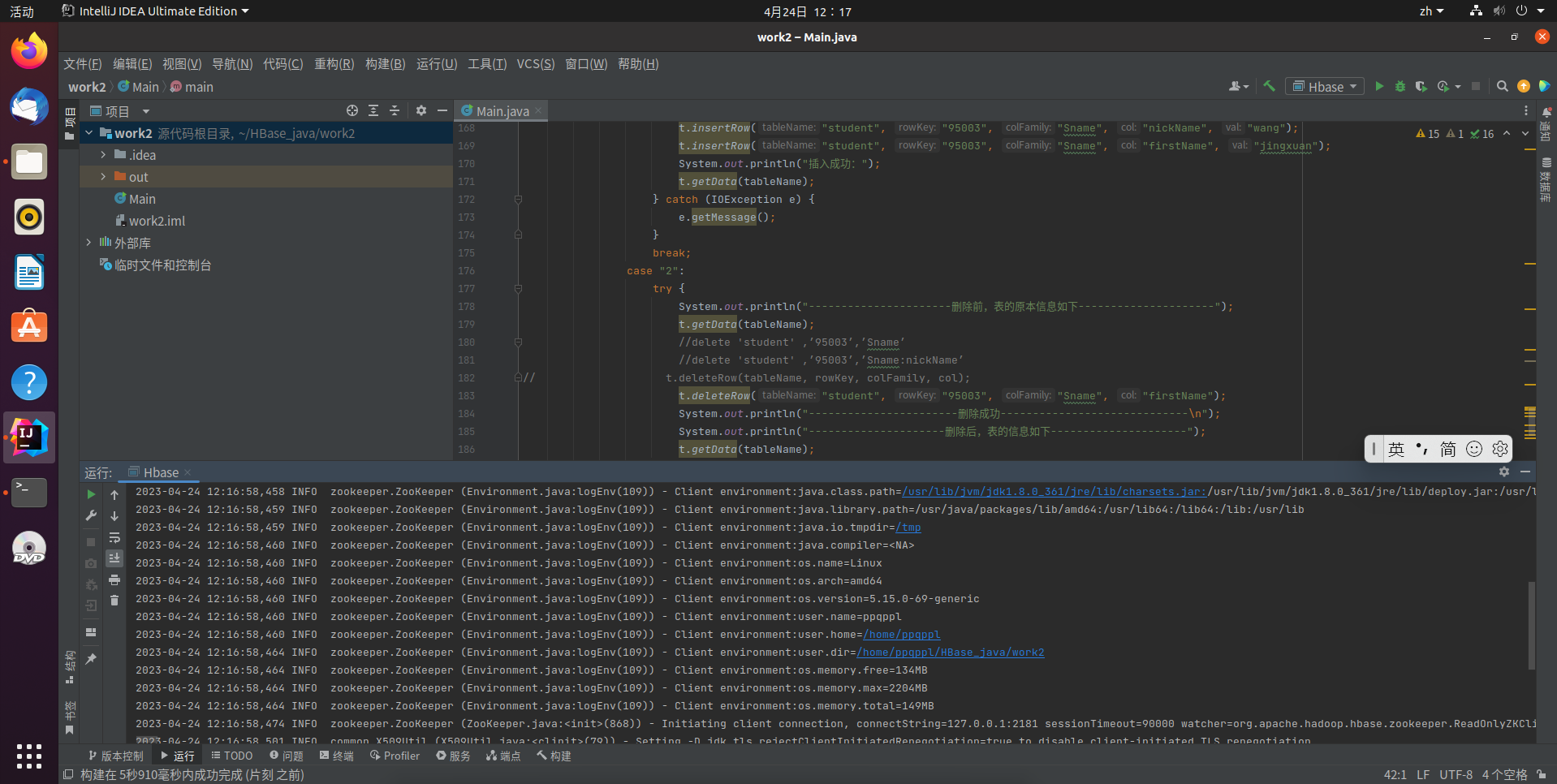
清空指定的表的所有记录数据:
import java.io.IOException; import java.util.Scanner; import org.apache.hadoop.conf.Configuration; import org.apache.hadoop.hbase.Cell; import org.apache.hadoop.hbase.CellUtil; import org.apache.hadoop.hbase.HBaseConfiguration; import org.apache.hadoop.hbase.HColumnDescriptor; import org.apache.hadoop.hbase.HTableDescriptor; import org.apache.hadoop.hbase.TableName; import org.apache.hadoop.hbase.client.Admin; import org.apache.hadoop.hbase.client.Connection; import org.apache.hadoop.hbase.client.ConnectionFactory; import org.apache.hadoop.hbase.client.HBaseAdmin; import org.apache.hadoop.hbase.client.Result; import org.apache.hadoop.hbase.client.ResultScanner; import org.apache.hadoop.hbase.client.Scan; import org.apache.hadoop.hbase.client.Table; import org.apache.hadoop.hbase.util.Bytes; public class Test_4 { public static Configuration configuration; public static Connection connection; public static Admin admin; // 建立连接 public static void init() { configuration = HBaseConfiguration.create(); configuration.set("hbase.rootdir", "hdfs://localhost:9000/hbase"); try { connection = ConnectionFactory.createConnection(configuration); admin = connection.getAdmin(); } catch (IOException e) { e.printStackTrace(); } } // 关闭连接 public static void close() { try { if (admin != null) { admin.close(); } if (null != connection) { connection.close(); } } catch (IOException e) { e.printStackTrace(); } } /** * * 清空制定的表的所有记录数据 * * @param args * * @throws IOException * */ public static void clearRows(String tableName) throws IOException { init(); HBaseAdmin admin1 = new HBaseAdmin(configuration); // 读取了之前表的表名 列簇等信息,然后再进行删除操作。 HTableDescriptor tDescriptor = admin1.getTableDescriptor(Bytes.toBytes(tableName)); // 总思想是先将原表结构保留下来,然后进行删除,再重新依据保存的信息重新创建表。 TableName tablename = TableName.valueOf(tableName); // 删除表 admin.disableTable(tablename); admin.deleteTable(tablename); // 重新建表 admin.createTable(tDescriptor); close(); } /** * * 根据表名查找表信息 * */ public static void getData(String tableName) throws IOException { init(); Table table = connection.getTable(TableName.valueOf(tableName)); Scan scan = new Scan(); ResultScanner scanner = table.getScanner(scan); for (Result result : scanner){ showCell((result)); } close(); } /** * * 格式化输出 * * @param result * */ public static void showCell(Result result) { Cell[] cells = result.rawCells(); for (Cell cell : cells) { System.out.println("RowName(行键):" + new String(CellUtil.cloneRow(cell)) + " "); System.out.println("Timetamp(时间戳):" + cell.getTimestamp() + " "); System.out.println("column Family(列簇):" + new String(CellUtil.cloneFamily(cell)) + " "); System.out.println("column Name(列名):" + new String(CellUtil.cloneQualifier(cell)) + " "); System.out.println("value:(值)" + new String(CellUtil.cloneValue(cell)) + " "); System.out.println(); } } public static void main(String[] args) { Test_4 test_4 = new Test_4(); Scanner scan = new Scanner(System.in); System.out.println("请输入要清空的表名"); String tableName = scan.nextLine(); try { System.out.println("表原来的信息:"); test_4.getData(tableName); test_4.clearRows(tableName); System.out.println("表已清空:"); } catch (IOException e) { e.printStackTrace(); } } }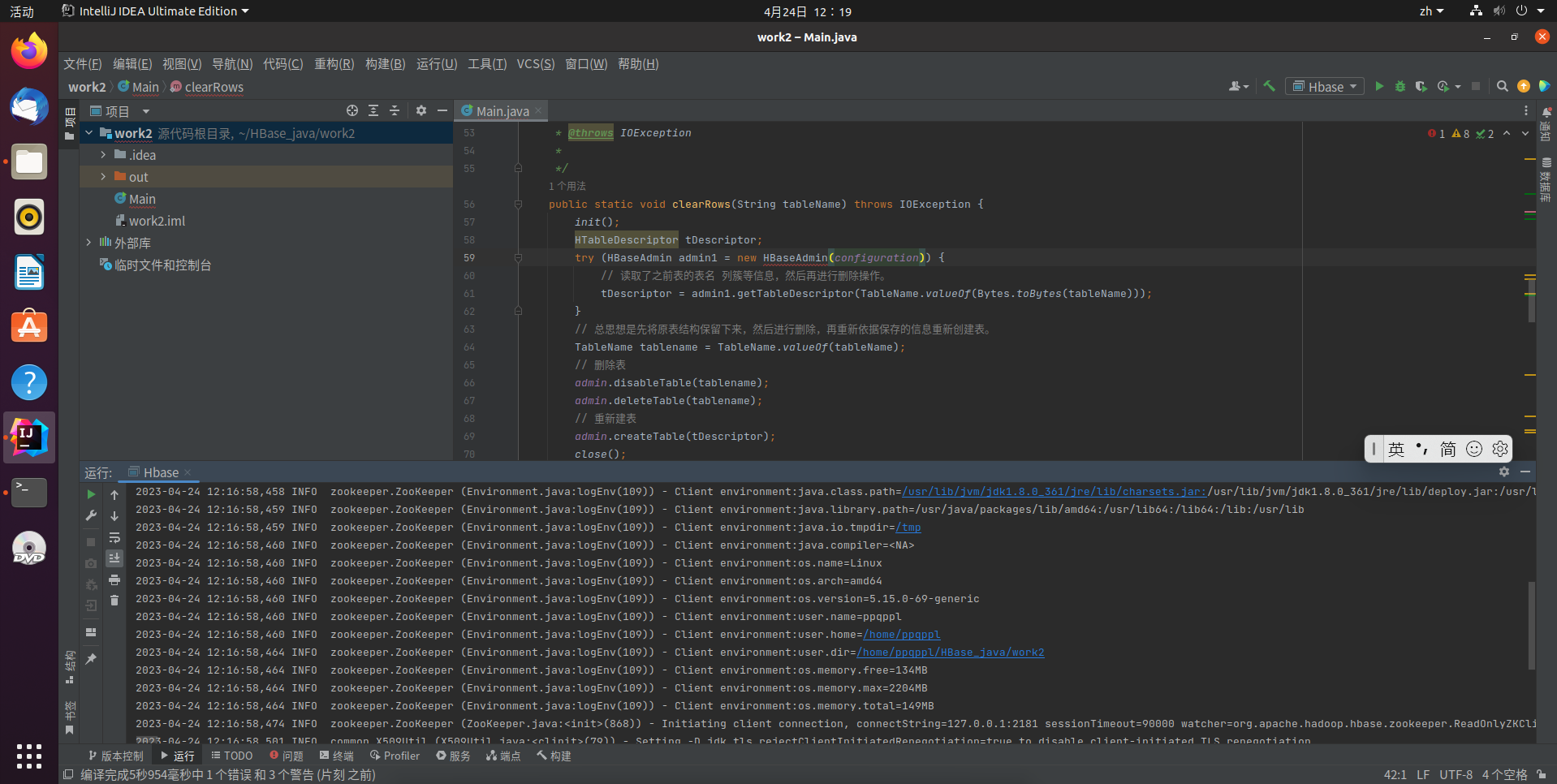
统计表的行数:
import java.io.IOException; import java.util.Scanner; import org.apache.hadoop.conf.Configuration; import org.apache.hadoop.hbase.HBaseConfiguration; import org.apache.hadoop.hbase.TableName; import org.apache.hadoop.hbase.client.Admin; import org.apache.hadoop.hbase.client.Connection; import org.apache.hadoop.hbase.client.ConnectionFactory; import org.apache.hadoop.hbase.client.Result; import org.apache.hadoop.hbase.client.ResultScanner; import org.apache.hadoop.hbase.client.Scan; import org.apache.hadoop.hbase.client.Table; public class Test_5 { public static Configuration configuration; public static Connection connection; public static Admin admin; //建立连接 public static void init() { configuration = HBaseConfiguration.create(); configuration.set("hbase.rootdir", "hdfs://localhost:9000/hbase"); try { connection = ConnectionFactory.createConnection(configuration); admin = connection.getAdmin(); } catch (IOException e) { e.printStackTrace(); } } // 关闭连接 public static void close() { try { if (admin != null) { admin.close(); } if (null != connection) { connection.close(); } } catch (IOException e) { e.printStackTrace(); } } public static void countRows(String tableName) throws IOException{ init(); Table table = connection.getTable(TableName.valueOf(tableName)); Scan scan = new Scan(); ResultScanner scanner = table.getScanner(scan); int num = 0; for (Result result = scanner.next(); result != null; result = scanner.next()){ num++; } System.out.println("行数:" + num); scanner.close(); close(); } public static void main(String[] args) throws IOException { Test_5 test_5 = new Test_5(); Scanner scan = new Scanner(System.in); System.out.println("请输入要统计行数的表名"); String tableName = scan.nextLine(); test_5.countRows(tableName); } }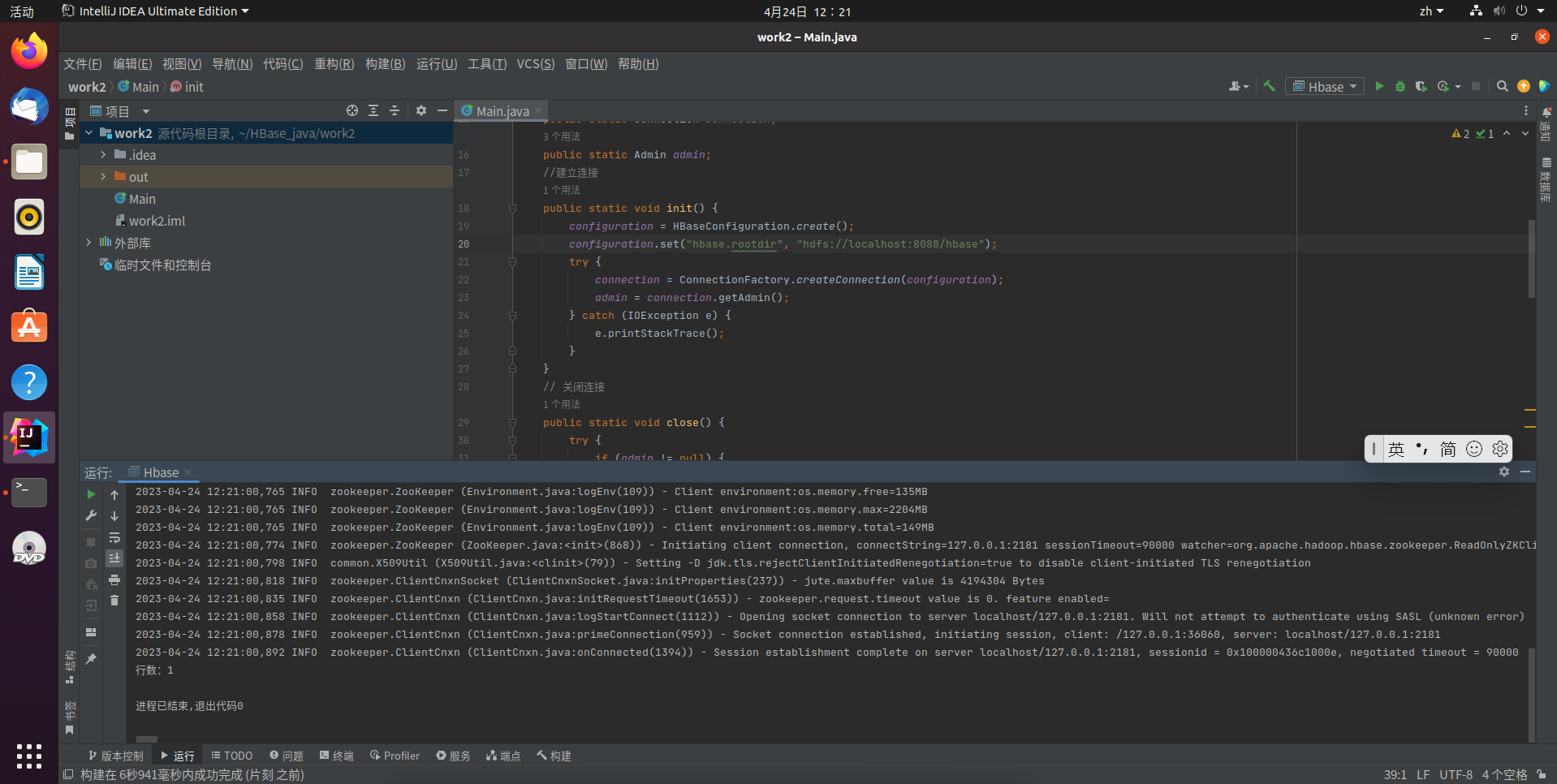
猜你喜欢
网友评论
- 搜索
- 最新文章
- 热门文章
